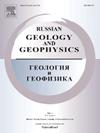Morphology and Composition Changes in Fluid Inclusions from Quartz under Progressive Deformation: Case Study of a Vein System in the Western Kelyan-Irokinda Fold Zone (Western Transbaikalia)
IF 1
4区 地球科学
Q3 GEOSCIENCES, MULTIDISCIPLINARY
引用次数: 0
Abstract
—The behavior of fluids during plastic deformation is studied from the morphology and distribution of fluid inclusions in quartz grains of different microstructure types from a vein system controlled by thrusting and strike-slip faulting in the eastern Sayan–Baikal fold area. The analytical work includes electron backscatter diffraction (EBSD) for quartz microstructure and crystallography, as well as Linkam heating-and-freezing analysis and Raman spectroscopy for the composition of fluid inclusions. The studied fluid inclusions are of seven types that differ in morphology and position in the deformed quartz structure. A model is suggested to describe successive structural changes of quartz aggregates during dislocation sliding and subsequent creep-related recrystallization associated with redistribution of fluid. Fluid inclusions undergo qualitative and quantitative changes due to water leakage at all stages of plastic deformation. The changes occur by two main mechanisms: (i) mass transfer during dislocation sliding at medium temperatures and strain rates and (ii) diffusion creep at low strain rates and high temperatures. The contribution of creep increases gradually with temperature, which maintains the interaction of inclusions with migrating grain boundaries.渐进式变形条件下石英流体包裹体形态和组成的变化——以西克拉扬—伊罗金达褶皱带(西外贝加尔)脉系为例
——从萨扬-贝加尔湖褶皱东部逆冲走滑断裂控制的脉系中不同微观结构类型石英颗粒中流体包裹体的形态和分布特征出发,研究了流体在塑性变形过程中的行为。分析工作包括电子背散射衍射(EBSD)分析石英微观结构和晶体学,以及Linkam加热和冷冻分析和拉曼光谱分析流体包裹体的组成。研究的流体包裹体有7种类型,它们在变形石英结构中的形态和位置各不相同。提出了一个模型来描述石英集合体在位错滑动过程中的连续结构变化以及随后与流体重分配相关的蠕变相关的再结晶。流体包裹体在塑性变形的各个阶段都因漏水而发生质变和量变。这种变化主要通过两种机制发生:(1)在中等温度和应变速率下位错滑动过程中的传质;(2)在低应变速率和高温下的扩散蠕变。随着温度的升高,蠕变的贡献逐渐增大,保持了夹杂体与迁移晶界的相互作用。
本文章由计算机程序翻译,如有差异,请以英文原文为准。
求助全文
约1分钟内获得全文
求助全文
来源期刊

Russian Geology and Geophysics
地学-地球科学综合
CiteScore
2.00
自引率
18.20%
发文量
95
审稿时长
4-8 weeks
期刊介绍:
The journal publishes original reports of theoretical and methodological nature in the fields of geology, geophysics, and geochemistry, which contain data on composition and structure of the Earth''s crust and mantle, describes processes of formation and general regularities of commercial mineral occurrences, investigations on development and application of geological-geophysical methods for their revealing. As to works of regional nature, accelerated publication are available for original papers on a variety of problems of comparative geology taking into account specific character of Siberia, adjacent Asian countries and water areas. The journal will also publish reviews, critical articles, chronicle of the most important scientific events, and advertisements.
 求助内容:
求助内容: 应助结果提醒方式:
应助结果提醒方式:


